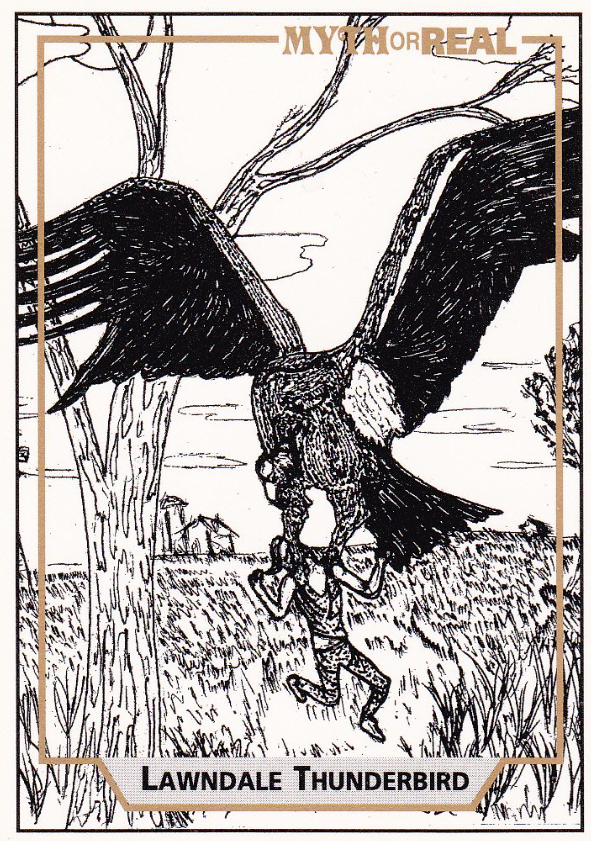Thunderbird Cryptid: Bird with a 70ft Wingspan
A thunderbird cryptid display in a museum.
The Thunderbird Cryptid is a giant bird resembling a condor or vulture that has been seen all over the United States.
Description of the Thunderbird Cryptid
Thunderbirds, as described in George M. Eberhart's Mysterious Creatures: A Guide to Cryptozoology, are massive and intimidating birds with a wingspan that can reach up to 70 feet.
Described as resembling vultures or condors, thunderbirds have dark feathers, a light head, and occasionally, a white feather collar around their necks.
In addition to their mysterious movements through the sky, these birds have been known to abduct small animals such as calves, dogs, and in rare cases, children.
In contrast, the largest bird in North America, the California condor, has a wingspan of only 10 feet, while the wandering albatross, the largest bird in the world, has a wingspan of 12 feet.
We need to look to the past to find a larger bird, as some teratorns from prehistoric times had wingspans of 20 feet. Thunderbirds are even larger than some planes.
The thunderbird cryptid is a phenomenon that spans across the continent, originating from the myths and beliefs of multiple tribes who depict its image on rocks and totem poles.
In the legends of various tribes such as the Comanche, Chippewa, and Mandan, the thunderbird was believed to be the cause of storms, with its eyes emitting lightning and its wings producing thunder.
Despite being considered a benevolent creature towards humans, it engaged in intense battles with formidable opponents like giant snakes and killer whales, demonstrating its ferocity.
Thunderbird Sightings
The thunderbird cryptid as seen at North Dakota’s Writing Rocks.
Located in the northwest corner of North Dakota, at the border of Montana and Saskatchewan, is the Writing Rocks State Historic Site. Here, beneath a modest awning and protected by a rebar barrier, sit a pair of unassuming, four-foot-wide granite boulders adorned with petroglyphs of thunderbirds that are believed to date back between 300 to over 1,000 years.
One of the most well-known accounts dates back to 1890, when two cowboys in Arizona asserted that they had shot and killed a sizable bird. According to their description, the creature lacked feathers and possessed a head resembling that of an alligator. After taking down the bird, the cowboys reportedly transported its lifeless body back to town. The report implies that the creature resembled more of a pterodactyl or dragon rather than any bird known to exist today.
A thunderbird attempts to fly away with a child in Lawndale, Illinois. Photo: Cryptid Wiki
Another infamous thunderbird sighting happened in Lawndale, Illinois. At approximately 8 p.m. on July 25, 1977, 10-year-old Marlon Lowe was playing in his backyard while his mother, Ruth, was cleaning up in the kitchen.
Suddenly, she heard her son scream and rushed outside to witness two enormous birds with wingspans measuring nine or 10 feet attacking him. The birds relentlessly pecked at Marlon's head and shoulders until one of them lifted the 56-pound boy 35 feet into the air.
Eventually, the birds abandoned their attempt to capture the child and disappeared.
Possible Explanations for the Thunderbird
Although thunderbirds have been suggested to be modern-day teratorns, this seems unlikely as no flying bird larger than an albatross or Andean condor has been discovered recently. While unlikely, it's not impossible that they still exist.
Pterosaurs have been considered as suspects in thunderbird sightings, but this theory seems far-fetched as pterosaurs are believed to have gone extinct during the Late Cretaceous period around 66 million years ago.
Exotic non-native birds such as African crowned eagles and Andean condors may have contributed to thunderbird sightings by escaping from captivity, with African crowned eagles reportedly causing so-called "thunderbird attacks" and Andean condors sometimes being mistaken for the larger mythical thunderbird at first glance.
Some have suggested that thunderbird sightings may be hoaxes carried out by pranksters, or simply cryptid enthusiasts' cases of misidentifying real/native American birds.
Have you ever seen a thunderbird? Let us know in the comments!
If you enjoyed learning about the thunderbird cryptid you might also be interested in learning about the Palmyra Wolves or Ukraine’s Mutant Spider
Further Reading
(Affiliate Link, we may earn a commission if you make a purchase.)
Mysterious Creatures: A Guide to Cryptozoology - Volume 2
George M. Eberhart

































